Hinduism in Australia
| Total population | |
|---|---|
|
440,300 (2016) 1.90% of the Australian Population | |
| Regions with significant populations | |
| Sydney · Canberra · Melbourne · Adelaide · Perth · Brisbane | |
| Languages | |
| English, Indian Languages, Mauritian Creole |
| Historical population | ||
|---|---|---|
| Year | Pop. | ±% |
| 1986 | 21,500 | — |
| 1991 | 43,580 | +102.7% |
| 1996 | 67,270 | +54.4% |
| 2001 | 95,473 | +41.9% |
| 2006 | 148,123 | +55.1% |
| 2011 | 275,534 | +86.0% |
| 2016 | 440,300 | +59.8% |
Hinduism is a major religion in Australia consisting of more than 440,300 followers, making up 1.9% of the population as of the 2016 census, up from 275,000 individuals representing 1.3% of the total Australian population according to the 2011 census[1] (up from 148,119 in the 2006 census).[2] Hinduism is one of the fastest growing religions in Australia mostly through immigration.[3] Hinduism is also one of the most youthful religions in Australia, with 34% and 66% of Hindus being under the age of 14 and 34 respectively.[4]
In the 19th century, the British first brought Hindus from India to Australia to work on cotton and sugar plantations. Many remained as small businessmen, working as camel drivers, merchants and hawkers, selling goods between small rural communities. These days Hindus are well educated professionals in fields such as medicine, engineering, commerce and information technology, constituting a model minority. The Hindus in Australia are mostly of Indian, Sri Lankan, Fijian, Malaysia, Singapore, Nepali, and Bangladesh origin, with some originating from other parts of the Indian subcontinent including Sindh.
The majority of Australian Hindus live along the Eastern Coast of Australia and are mainly located in the cities of Melbourne and Sydney. According to the 2016 census, the Hindu population numbered 440,310 individuals, of whom 39% lived in Greater Sydney, 29% in Greater Melbourne, and 8% each in Greater Brisbane and Greater Perth. The states and territories with the highest proportion of Hindus are the Australian Capital Territory (2.57%) and New South Wales (2.43%), whereas those with the lowest are Queensland (0.98%) and Tasmania (0.50%).[5] As a community Hindus live relatively peacefully and in harmony with the local populations. They have established a number of temples and other religious meeting places and celebrate most Hindu festivals.
| Year | Percent | Increase |
|---|---|---|
| 1986 | 0.14% | - |
| 1991 | 0.25% | +0.11% |
| 1996 | 0.38% | +0.13% |
| 2001 | 0.51% | +0.13% |
| 2006 | 0.75% | +0.24% |
| 2011 | 1.28% | +0.53% |
| 2016 | 1.90% | +0.62% |
Timeline
The following dates briefly outline the arrival of Hinduism.
- As early as 300AD – Indonesian Hindu merchants make contact with Australian Aborigines.
- 1788 – Indian crews from Bay of Bengal came to Australia on trading ships.[6]
- 1816 – Domestic servants in European households left the port of Calcutta to take up labouring work in Sydney.
- 1844 – P. Friell who had previously lived in India, brought 25 domestic workers from India to Sydney and these included a few women and children.[7]
- 1850s – A Hindu Sindhi merchant, Shri Pammull, built a family opal trade in Melbourne that has prosperously continued with his third-to fourth-generation descendants.[8]
- 1857 – The census showed a mere 277 Hindus in Victoria. The gold rush years attracted many Indians to Australia and across the borders to the gold mines in Victoria.
- 1893 – The census showed that 521 Hindus were living in New South Wales.
- 1901 – Just about 800 Indians lived in Australia, the majority of them lived in northern NSW and Queensland.
- 1911 – The census counted 3698 Hindus in the entire country.[9]
- 1921 – Less than 2200 Indians lived in Australia.
- 1971 – Swami Prabhupada arrives in Australia and founded first Hare Krishna centre in Sydney.[10]
- 1977 – The first Hindu temple in Australia, the Sri Mandir Temple, was built. Established by three devotees; Dr Prem Shankar (from Ujhani, UP), Dr Padmanabn Shrindhar Prabhu and Dr Anand, who bought an old house in Auburn NSW and paid $12000.00 to convert it into a temple.[11][12]
- 1981 – The census recorded 12,466 Hindus in Victoria and 12,256 in NSW from a total of 41,730 in the entire country.
- 1985 – A Hindu society, the Saiva Manram, was formed to build a temple for Lord Murukan. Since its inception, Lord Murukan has been called 'Sydney Murukan'. The Saiva Manram has worked hard for nearly ten years to build a temple for Lord Murukan.
- 1986 – According to the 1986 census, the number of Hindus in Australia surpasses 21,000.
- 1991 – According to the 1991 census, the number of Hindus in Australia surpasses 43,000.
- 1996 – Hindus with their birthplace in India made up 31 per cent of all Hindus in Australia. But the census also showed there were 67,270 Hindus living in Australia.[13]
- 2001 – According to the 2001 census, the number of Hindus in Australia surpasses 95,000.[14]
- 2003 – Sri Karphaga Vinayakar Temple was formed to build a temple for Lord Ganesha/Ganapathi/Vinayakar. Since its inception, Lord Ganesh has been called 'Sydney Ganesh Temple'. "www.vinayakar.org.au"
- 2006 – According to the 2006 census, the number of Hindus in Australia surpasses 145,000.[15]
- 2011 – According to the 2011 census, the number of Hindus in Australia surpasses 275,000.[16]
- 2015 – Daniel Mookhey becomes the first Australian MP to be sworn into office by swearing his/her oath on the Bhagavad Gita.[17]
- 2016 - 2016 Census data states that Hindus comprise almost 2% of the Australian population, surpassing the percentage of Hindus(1.85%, as of the latest 1998 Census) in Pakistan.
Hindus by State/Territory
Data from the 2011 Census showed that all states(and A.C.T and the Northern Territory) apart from New South Wales had their Hindu population double from the 2006 census. New South Wales has had the largest number of Hindus since at least 2001.
| State/Territory | Population 2016 Census | Percentage 2016 Census | Population 2011 Census | Percentage 2011 Census | 2011–2016 Growth | Reference |
|---|---|---|---|---|---|---|
| New South Wales | 181,402 | 2.4% | 119,843 | 1.7% | +61,559 | [18] |
| Victoria | 134,939 | 2.3% | 83,102 | 1.6% | +51,837 | [19] |
| Queensland | 45,961 | 1.0% | 28,609 | 0.7% | +17,352 | [20] |
| Western Australia | 38,739 | 1.6% | 21,048 | 0.9% | +17,691 | [21] |
| South Australia | 22,922 | 1.4% | 13,616 | 0.9% | +9,306 | [22] |
| Australian Capital Territory | 10,211 | 2.6% | 6,053 | 1.7% | +4,158 | [23] |
| Northern Territory | 3,562 | 1.6% | 1,642 | 0.8% | +1,920 | [24] |
| Tasmania | 2,554 | 0.5% | 1,608 | 0.3% | +946 | [25] |
| State/Territory | Population 2011 Census | Percentage 2011 Census | Population 2006 Census | Percentage 2006 Census | 2006–2011 Growth | Reference |
|---|---|---|---|---|---|---|
| New South Wales | 119,843 | 1.7% | 73,717 | 1.1% | +46,126 | [26] |
| Victoria | 83,102 | 1.6% | 42,248 | 0.9% | +40,854 | [27] |
| Queensland | 28,609 | 0.7% | 14,040 | 0.4% | +14,569 | [28] |
| Western Australia | 21,048 | 0.9% | 8,110 | 0.4% | +12,938 | [29] |
| South Australia | 13,616 | 0.9% | 5,114 | 0.3% | +8,502 | [30] |
| Australian Capital Territory | 6,053 | 1.7% | 3,289 | 1.0% | +2,764 | [31] |
| Northern Territory | 1,642 | 0.8% | 536 | 0.3% | +1,106 | [32] |
| Tasmania | 1,608 | 0.3% | 784 | 0.2% | +824 | [33] |
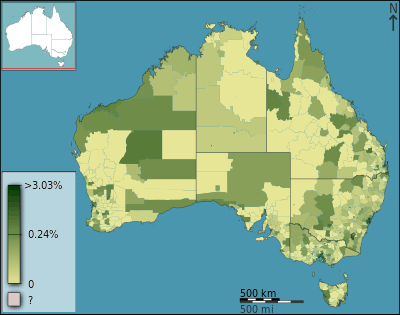
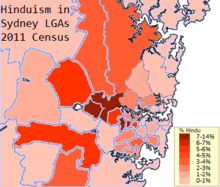
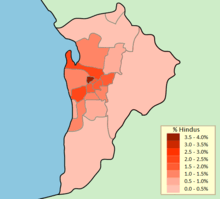
Hindu temples in Australia
Demographics

According to the 2006 Census, 44.16% of all Australians who were born in India were Hindu, so were 47.20% of those born in Fiji, 1.84% born in Indonesia, 3.42% from Malaysia, and 18.61% from Sri Lanka.[34]
Languages
Less than 17% of the Australian Hindus use English as their home language. The number of Australian Hindus speaking various languages as their home language are:[35]
| Language | Y 2011 | Y 2016 | Change |
|---|---|---|---|
| Total | 275,534 | 440,300 | 59.80% |
| Hindi | 81,892 | 119,284 | 45.66% |
| English | 39,800 | 58,855 | 47.88% |
| Tamil | 36,940 | 53,766 | 45.55% |
| Nepali | 21,766 | 50,629 | 132.61% |
| Gujarati | 29,250 | 45,884 | 56.87% |
| Telugu | 16,717 | 30,723 | 83.78% |
| Punjabi | 9,442 | 16,546 | 75.24% |
| Malayalam | 5,938 | 11,687 | 96.82% |
| Marathi | 8,774 | 11,589 | 32.08% |
| Kannada | 5,383 | 8,783 | 63.16% |
| Bengali | 5,685 | 8,481 | 49.18% |
| South Asian nfd | 3,531 | 3,770 | 6.77% |
| Indonesian | 1,171 | 1,755 | 49.87% |
| French | 1,180 | 1,401 | 18.73% |
| Fijian Hindustani | 572 | 1,257 | 119.76% |
| Mauritian Creole | 514 | 883 | 71.79% |
| Konkani | 609 | 845 | 38.75% |
| Oriya | 282 | 694 | 146.10% |
| Indo-Aryan nfd | 1,988 | 633 | -68.16% |
| Malay | 435 | 591 | 35.86% |
| Tulu | 348 | 543 | 56.03% |
| Sindhi | 277 | 521 | 88.09% |
| Assamese | 165 | 302 | 83.03% |
| Vietnamese | 109 | 225 | 106.42% |
| Fijian | 129 | 213 | 65.12% |
| Sinhalese | 232 | 163 | -29.74% |
| Italian language | 158 | 158 | 0.00% |
| Balinese | 129 | 156 | 20.93% |
Oversea territories
Hinduism is practised by the small number of Malaysian Indians in Christmas Island.[36][37]
Image Gallery
 Sri Venkateswara Temple (SVT), Helensburgh, New South Wales
Sri Venkateswara Temple (SVT), Helensburgh, New South Wales Main Gopuram of the Sri Venkateswara Temple (SVT), Helensburgh, New South Wales
Main Gopuram of the Sri Venkateswara Temple (SVT), Helensburgh, New South Wales
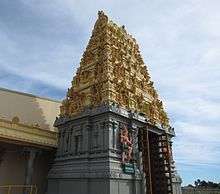 Lord Shiva Temple, Perth
Lord Shiva Temple, Perth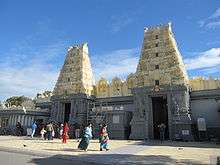 Shiva Vishnu Temple, Melbourne
Shiva Vishnu Temple, Melbourne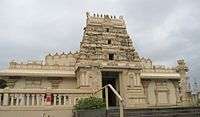 Lord Murugan Temple, Sydney
Lord Murugan Temple, Sydney
See also
References
- ↑ Megan Levy (13 April 2012). "Snapshot of a nation: What the census revealed about us". Theage.com.au. Retrieved 15 December 2017.
- ↑ "2006 Census Table : Australia". Censusdata.abs.gov.au. Retrieved 10 July 2013.
- ↑ "Melbourne's fastest-growing religion". Theage.com.au. 30 June 2008. Retrieved 10 July 2013.
- ↑ "Archived copy". Archived from the original on 23 March 2015. Retrieved 17 May 2015.
- ↑ "Census TableBuilder - Dataset: 2016 Census - Cultural Diversity". Australian Bureau of Statistics – Census 2016. Retrieved 29 July 2017.
- ↑ "Archived copy". Archived from the original on 30 April 2015. Retrieved 13 May 2015.
- ↑ "Indian overseas Population - Indians in Australia. Non-resident Indian and Person of Indian Origin". NRIOL.
- ↑ "Archived copy". Archived from the original on 24 September 2015. Retrieved 13 May 2015.
- ↑ "Archived copy". Archived from the original on 4 March 2016. Retrieved 13 May 2015.
- ↑ "Early Disciples Celebrate Forty Years of ISKCON in Australia".
- ↑ "History - SRI MANDIR". www.srimandir.org.
- ↑ "Archived copy". Archived from the original on 26 March 2016. Retrieved 13 May 2015.
- ↑ Statistics, c=AU; o=Commonwealth of Australia; ou=Australian Bureau of. "Main Features - Census shows non-Christian religions continue to grow at a faster rate". www.abs.gov.au.
- ↑ "Hinduism". www.ncls.org.au.
- ↑ "Archived copy". Archived from the original on 24 September 2015. Retrieved 15 May 2015.
- ↑ "Hindu fastest growing religion in australia - visareporter".
- ↑ Hasham, Nicole (12 May 2015). "Labor MLC Daniel Mookhey makes Australian political history by swearing on the Bhagavad Gita". The Sydney Morning Herald.
- ↑ "Religion - Australia - Community profile". profile.id.com.au.
- ↑ "Religion - Australia - Community profile". profile.id.com.au.
- ↑ "Religion - Australia - Community profile". profile.id.com.au.
- ↑ "Religion - Australia - Community profile". profile.id.com.au.
- ↑ "Religion - Australia - Community profile". profile.id.com.au.
- ↑ "Religion - Australia - Community profile". profile.id.com.au.
- ↑ "Religion - Australia - Community profile". profile.id.com.au.
- ↑ "Religion - Australia - Community profile". profile.id.com.au.
- ↑ "Religion - Australia - Community profile". profile.id.com.au.
- ↑ "Religion - Australia - Community profile". profile.id.com.au.
- ↑ "Religion - Australia - Community profile". profile.id.com.au.
- ↑ "Religion - Australia - Community profile". profile.id.com.au.
- ↑ "Religion - Australia - Community profile". profile.id.com.au.
- ↑ "Religion - Australia - Community profile". profile.id.com.au.
- ↑ "Religion - Australia - Community profile". profile.id.com.au.
- ↑ "Religion - Australia - Community profile". profile.id.com.au.
- ↑ "2914.0.55.002 2006 Census Ethnic Media Package" (Excel download). Census Dictionary, 2006 (cat.no 2901.0). Australian Bureau of Statistics. 27 June 2007. Retrieved 14 July 2008.
- ↑ "Census 2011 Australia | ABS Population Income | SBS Census Explorer". Sbs.com.au. Retrieved 10 July 2013.
- ↑ http://www.cidhs.cx/island-induction
- ↑ Simone Dennis (2008). Christmas Island: An Anthropological Study. Cambria Press. pp. 91–. ISBN 9781604975109.
Sources
Byrnes, J 2007,'Hinduism', Religion and Ethics <http://www.abc.net.au/religion/stories/s790133.htm> https://web.archive.org/web/20140812214434/http://www.theindiansun.com.au/top-story/australias-oldest-hindu-temple-readies-janmasthami/
External links
- http://www.chinmaya.com.au
- Hindu Council of Australia an umbrella organisation
- Vishva Hindu Parishad of Australia
- Hinduism Summit Melbourne
- Hindu Community Council of Victoria (HCCV)
- The Hindu Temple and Cultural Centre ACT
- Purohit Services Archived 26 June 2010 at the Wayback Machine.
- Religious Services
- Hindu Temples in Australia
- Hindu Swayamsevak Sangh

